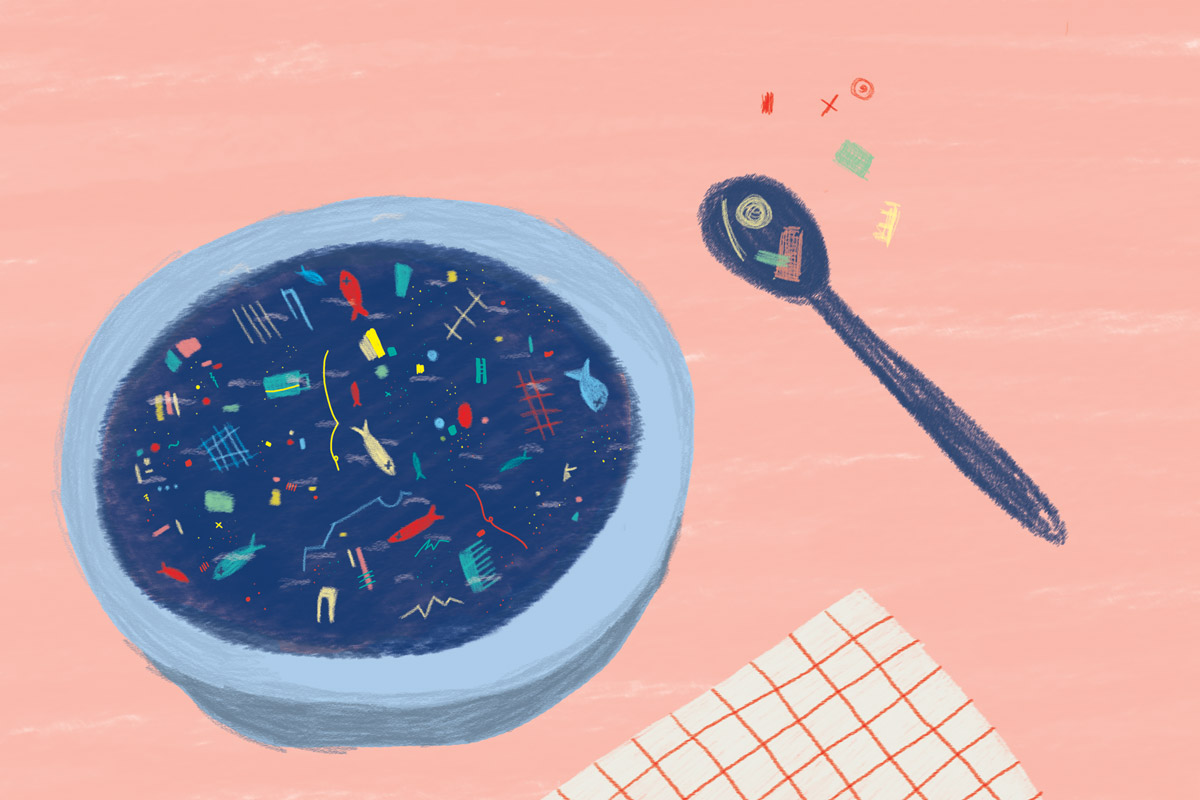Soup is the icon dish of this blog. It represents many things we like: genuine food, traditional knowledge, care, warmth.
Not all the soups are made alike, however, and there’s one particular version we’d never want on our plate. Believe it or not, you’re one of the cooks.
I’m talking about the “plastic soup” we’ve been cooking in our oceans for decades, for the future generations.
A more popular name for it is “Great Pacific Garbage Patch“, a definition that makes you picture a marine debris island floating in the Pacific Ocean. I hate to pop your bubble, but if that image would be true, it would actually be “good news”.
What is known as the Great Pacific Garbage Patch is in fact a trash vortex that collects marine debris, mainly plastic, for hundreds square kilometres, in two main areas of the Pacific Ocean. Unfortunately, that’s just the tip of the iceberg.
Due to the continuous action of tides, sunlight and other agents, solid plastic trash gets fractioned into small pieces, down to non-biodegradable toxic chemicals bound to poison the environment and its inhabitants (humans included) for centuries to come.
It should be clear, now, the reason it is more accurate to call this disaster a “soup” rather than an island.
What can we do?
There have been different studies highlighting how cleaning up this mess is practically impossible. Removing the solid part of the plastic soup alone would pose almost insurmountable technical challenges and costs that no nation alone could afford.
To name just one of the practical dilemmas on the table: how would you fish out tiny, almost invisible bits of plastic without catching living organisms of the same size?
During the World Economic Forum Annual Meeting, this year, a Ellen MacArthur Foundation report was released, warning that there could be more plastic than fish in the sea by 2050.
Should we just sit here and wait for it in shock, then? We don’t thing so.
The most feasible and immediate response is damage reduction, and that’s where every single person, as a consumer, matters.
Plastic is a great invention, but our industries got definitely carried away by its profitability (plastic has never been this cheap). We now find it in the most unnecessary and sly forms, attached to products we actually need.
From being a hygienic, versatile and durable material, plastic became something disposable, that often travels from our shopping bags straight into our trash bins, just to sit in the environment for hundreds of years further.
We believe change is on us and the way our awareness makes sense through everyday practices. That’s why As Soup As Possible invited Janna Selier, campaign manager for the Plastic Soup Foundation, to show us how even cooking a simple quiche can produce non-biodegradable trash that is highly harmful for marine life.
It’s simply up to us to spend our grocery money on food and sustainable products rather than packaging and unnecessary plastic, dispose of the inevitable plastic responsibly and tell producers to stop dumping plastic on us, the environment and the future of our children.
So let’s just make a quiche, not a plastic soup!
Ingredients and Process.
Ingredients:
Puff pastry – 1 roll
Flour – 2 spoonfuls
Cauliflower
Broccoli
Sun-dried tomatoes – 100g
Old Dutch cheese – 100g
Eggs – 3
Fresh Cream – 100ml
Salt, pepper, curry.
In case you feel up to the challenge of making your own puff pastry and spare some more unnecessary plastic waste, here’s Gordon Ramsey’s recipe.
Self-production is key to reducing waste. We’re aware that in many cases current life-styles and industrial systems leave you little choice, so if you really have to buy a ready-made, go for brands that make an effort to use little packaging and sustainable materials.
Wash the cauliflower and broccoli and cut them into small pieces.
Bring a pot of water to boil and cook the veggies for 10 minutes.
Meanwhile, cut the sun-dried tomatoes roughly and mix them in a bowl with the rest of the filling.
Grease a baking tin and line it with puff pastry.
The vegetables will be ready; strain them in a colander, making sure to drain all the water out. Stir them into the rest of the mix and fill the puff pastry base with it.
Place it into the oven (preheated at 180 degrees C / 356 degrees F) for about 30 minutes.
If you’re not sure it’s cooked through, prick the centre with a toothpick and check if it comes out clean.
Let it cool down a little and enjoy!
 Italian designer and illustrator Alice Spadaro created the cover for this post.
Italian designer and illustrator Alice Spadaro created the cover for this post.
Alice’s artworks combine neat and simple shapes in a witty perspective on food and nature.
She moves across different media with the same light and insightful glance on everyday-life details.
Alice Spadaro is based in Amsterdam and is the co-founder of internoconcucina design studio.
You can follow her on Instagram.
Special thanks to Janna Selier.
For more info, visit The Plastic Soup Foundation website or Facebook page.
To download the Beat The Microbead App, click here.



